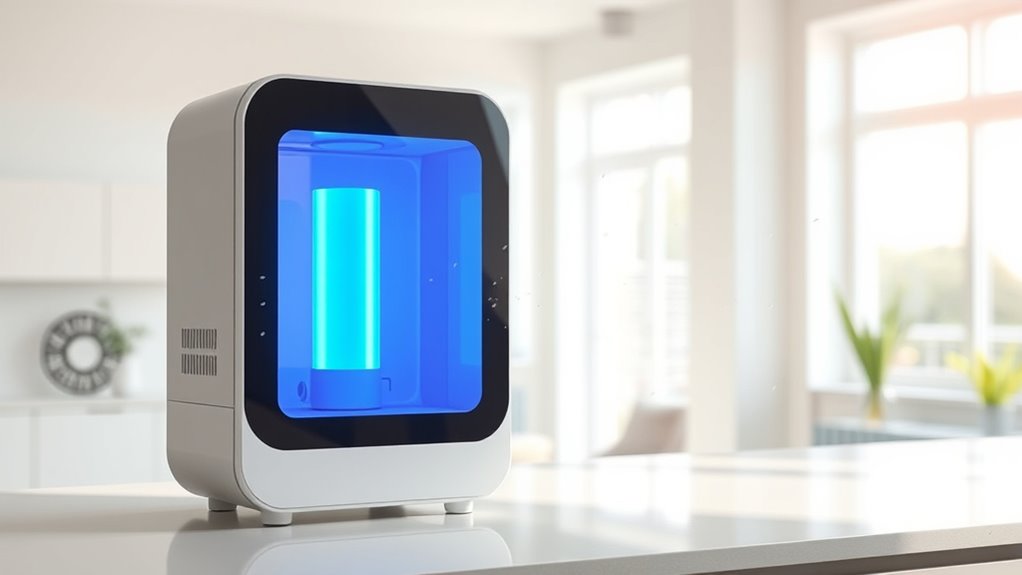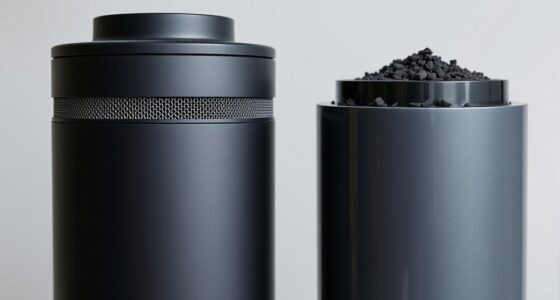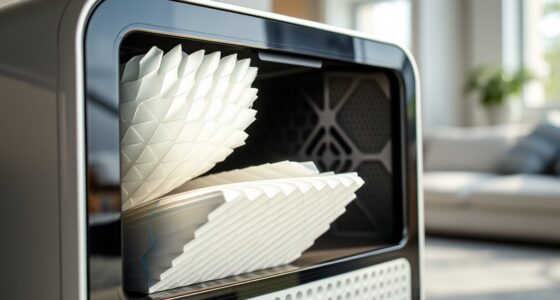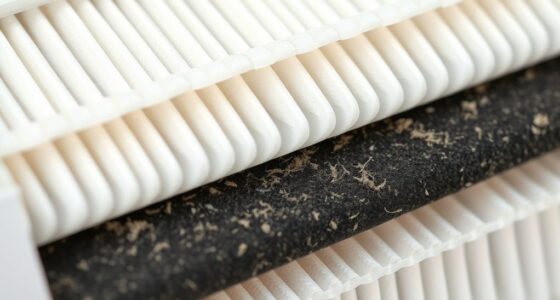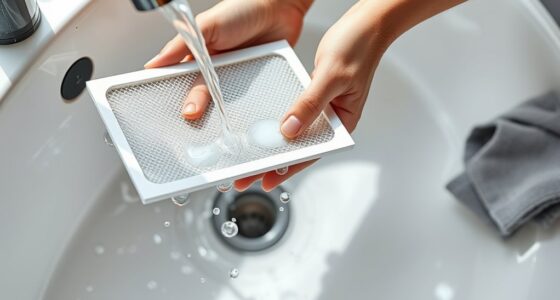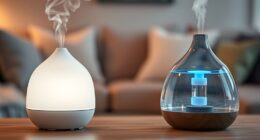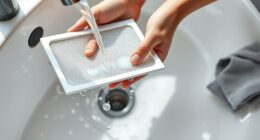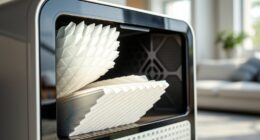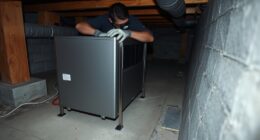Adding UV lamps to your air purifier boosts its ability to eliminate bacteria, viruses, and mold spores, leading to cleaner, safer indoor air. UV sterilization damages the genetic material of harmful microorganisms, preventing them from reproducing. These lamps work silently with minimal maintenance and don’t produce harmful chemicals. Just be sure to follow safety guidelines to avoid UV exposure. If you want to discover more about how UV lamps can improve your air quality safely, there’s plenty more to learn.
Key Takeaways
- UV lamps enhance air purifier effectiveness by actively destroying bacteria, viruses, and mold spores through UV sterilization.
- They damage the DNA and RNA of pathogens, preventing reproduction and reducing airborne infections.
- Proper enclosure and following safety guidelines prevent UV exposure risks to skin and eyes during operation.
- Regular maintenance and timely replacement of UV lamps ensure continuous, safe, and efficient sterilization performance.
- Combining UV lamps with good ventilation and filter maintenance maximizes indoor air quality safely.
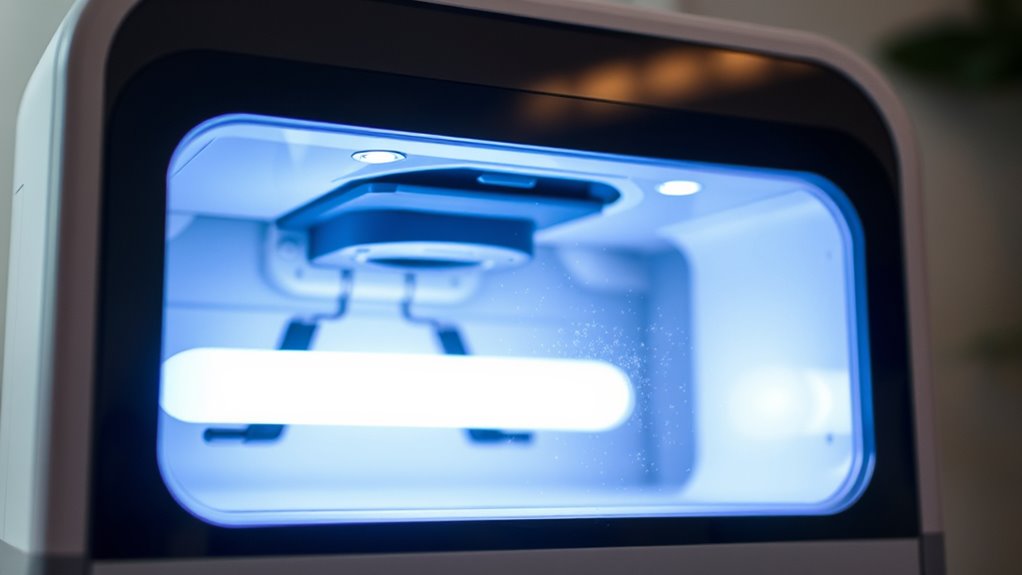
Adding UV lamps to air purifiers can substantially enhance their ability to eliminate bacteria, viruses, and mold spores from the air you breathe. This process, known as UV sterilization, uses ultraviolet light to target and destroy harmful microorganisms, notably improving air quality in your home or office. When UV lamps are integrated into your air purifier, they work alongside traditional filters to provide a multi-layered defense against airborne contaminants. While HEPA filters trap particles like dust and pollen, UV sterilization actively neutralizes microorganisms that might otherwise pass through or linger. This combination ensures your environment’s air is cleaner, healthier, and safer to breathe.
By installing UV lamps, you’re taking an extra step toward reducing the presence of pathogens in your indoor air. UV sterilization is particularly effective because it damages the DNA and RNA of bacteria and viruses, rendering them incapable of reproducing or causing infection. This process is chemical-free and doesn’t produce harmful byproducts, making it a safe addition to your air purification system. Many modern air purifiers now come with built-in UV lamps, designed to operate efficiently without requiring much maintenance. When functioning properly, they can continuously disinfect the circulated air, especially in spaces prone to high humidity or frequent microbial growth. Additionally, the integration of AI in Business technologies can optimize the operation and monitoring of UV sterilization systems, ensuring maximum effectiveness.
However, safety is essential when considering UV lamps. UV radiation can be harmful to your skin and eyes if directly exposed, so it’s important to ensure the lamps are properly enclosed within the purifier. Manufacturers typically design these units to prevent UV exposure to users, but it’s wise to follow all safety instructions and avoid opening the device while it’s operating. Additionally, UV lamps have a limited lifespan and should be replaced according to the manufacturer’s recommendations to maintain ideal sterilization effectiveness. When used correctly, UV sterilization can be a reliable and safe way to boost air quality.
You should also keep in mind that UV lamps are most effective when combined with good ventilation and regular cleaning routines. While they markedly reduce microbial presence, they aren’t a substitute for other cleaning practices. Regularly replacing filters, wiping surfaces, and ensuring proper room ventilation will maximize the benefits of your air purifier with UV technology. Overall, adding UV lamps to your air purifier can be a highly effective method for improving indoor air quality by actively destroying harmful microorganisms. Just make sure to prioritize safety and follow the manufacturer’s instructions to enjoy cleaner, healthier air every day.
Frequently Asked Questions
Do UV Lamps Emit Any Harmful Ozone?
UV lamps in air purifiers can emit small amounts of ozone, raising ozone concerns. However, many modern UV lamps are designed with UV safety in mind, minimizing ozone production. To protect your health, choose models labeled as ozone-safe or low-ozone, and guarantee proper ventilation. This way, you enjoy the benefits of UV technology without worrying about harmful ozone exposure.
How Often Should UV Lamps Be Replaced?
Think of your UV lamp as a vital guardian, standing watch over your air. Typically, you should replace it every 9 to 12 months, depending on the lamp’s lifespan and usage. Regular replacement guarantees peak performance, much like renewing a shield. Keep an eye on manufacturer recommendations and your purifier’s indicator lights. By sticking to these intervals, you maintain safe, effective purification and prevent any decline in UV effectiveness.
Are UV Lamps Effective Against All Airborne Pathogens?
UV lamps are effective against many airborne viruses and bacteria, but they may not eliminate all pathogens due to pathogen resistance and varying exposure levels. You should understand that UV light can deactivate many, but not necessarily every airborne pathogen. For maximum protection, combine UV air purifiers with other filtration methods. Regularly maintain and replace UV lamps as recommended to guarantee consistent effectiveness against airborne viruses.
Can UV Lamps Cause Any Material Degradation?
UV lamps can cause material degradation over time, especially if exposed to prolonged UV radiation, which may weaken plastics and fabrics. Studies show that certain materials degrade faster when exposed to UV light, impacting material safety and lamp durability. To minimize risks, verify your air purifier uses UV lamps with appropriate shielding and follow manufacturer guidelines. Regularly replacing lamps helps maintain both safety and efficiency, protecting your home and ensuring long-term durability.
Is Professional Installation Required for UV Lamp Integration?
You should consider professional installation for UV lamps in air purifiers to guarantee safety considerations are properly addressed. Skilled technicians understand how to install UV lamps correctly, minimizing risks like electrical hazards or improper placement that could cause material degradation or safety issues. By opting for professional installation, you guarantee the UV lamp functions effectively without compromising your device’s safety or longevity, giving you peace of mind and ideal air purification.
Conclusion
By adding UV lamps, you enhance your air purifier’s ability to eliminate germs and pollutants, creating a cleaner environment. Yet, remember, safety isn’t optional—UV light can be harmful if misused. While your air gets healthier, you must stay cautious. The power to breathe easier and stay protected is in your hands; balancing the benefits with safety measures guarantees you enjoy fresher air without risk. Embrace the upgrade, but never compromise safety for cleanliness.
